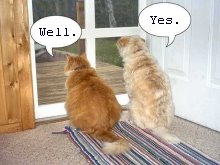 Beaver Grove Bison: This article originally appeared in the September 2008 issue of Marquette Monthly.
Beaver Grove Bison: This article originally appeared in the September 2008 issue of Marquette Monthly.If I say, “Picture a buffalo herd,” does your mind go to the open plains of the Dakotas where grass and sky stretch beyond the horizon, beyond imagination? Do you see hundreds of buffalo idly grazing on a grassy expanse? Do you see an uncountable number galloping as one in a billow of dust, a long snaky line of shaggy brown with no beginning, no end, trailing off into a sunset? How about a handful of about 18 buffalo tearing across a stubbled field surrounded by woods of pine and maple?
If you can picture the latter, maybe you’ve been to Beaver Grove Bison on County Road 480 just south of Marquette, Michigan, and perhaps Jerri Haglund was tossing hamburger buns over a 7-foot fence as the bison came running, because the bison love hamburger buns.
Buffalo and bison are one and the same. Bison is the scientific term; buffalo is the term used by early explorers, those who saw a beast that looked like the native buffaloes of India and Africa and who perhaps heard the French calling them “les boeufs.” In those days, the American buffalo herds were vast, spanning a range from the Rocky Mountains eastward, trickling past the Mississippi to the Atlantic, stretching from Canada into Mexico. In 1800, the estimated number of buffalo was as high as 60 million, and those commanding herds are etched into our collective memory, stirring up feelings of pioneer spirit, freedom, and wildness. It is a messy fact that our European-American ancestors killed these buffalo mercilessly, not hunting them for food or warmth but simply to get rid of them. By the 1880s they had nearly succeeded.
Luckily, 100 or so years later, ranchers in the Great Plains began raising bison for meat, and buffalo started staging a comeback, of sorts. Now one can find bison ranches in all 50 states and buffalo burgers at the county fair. The National Bison Association estimates that in 2002 there were 500,000 bison in North America with 232,000 on ranches in the U.S. In the Upper Peninsula there are at least 168 bison, including the 18 in Beaver Grove and a herd of 150 at the Circle K Ranch in Rudyard, which Orville and Susan Kabat started in 1988. (There is also a rumor of three buffalo in Champion, but the rumor is also that they are kept as pets.)
Jerri and her brother, Bob Haglund, started Beaver Grove Bison about eight years ago with seven animals bought from the Circle K. Jerri and Bob grew up in the house they live in, and, Jerri said, they have always had animals. Their dad, now deceased, was a hobby farmer, raising cows and horses, mostly as pets. Bringing in buffalo was Bob’s idea.
“Since I was a kid I wanted them,” Bob said. “I was fascinated by them. … They’re unique. Something no one else has.”
As a kid, Bob never heard of anyone raising buffalo on a farm. All he heard was that buffalo are wild and can’t be controlled. Then he noticed a small herd at the Bahrman’s place in Skandia. Suddenly the idea that buffalo could be kept on a farm didn’t seem so farfetched, but convincing others would take a while. Although his idea of raising buffalo took hold in the 1980s, Bob said serious research didn’t start until about 10 years later.
“We got a computer, and Jerri got a cowboys and Indians book, and on the back it had the website for the National Buffalo Association,” Bob said. “So we went on there and started doing research, and we started going around, hitting farms, like Orv’s and in Wisconsin.”
Still, some people told Bob he couldn’t do it. Increasingly his response became: “Well look it, people do it.”
For now, both Haglunds work other jobs, Jerri in a bank and Bob construction, but they hope someday to concentrate on the farm and the bison. Bob’s fascination with buffalo has not waned.
“Every day you learn something new about them, they do something different,” he said. “They’re fun. … A lot of it’s body language, the way they handle themselves.”
Bison are raised as naturally as possible without antibiotics or added hormones. Year-round they live outside, grazing on grass, sometimes hay, and, in Beaver Grove, the occasional hamburger bun.
 “They’re pretty much maintenance-free,” Jerri said, “as long as the fence is up.”
“They’re pretty much maintenance-free,” Jerri said, “as long as the fence is up.”The fence surrounds the 30 acres of pasture upon which the buffalo roam. Although kept captive by fences, bison are not considered domesticated animals. As Jerri said, “The buffalo still have that wild streak,” and you can see it in their eyes. Occasionally the Haglund’s main bull gets that “look” and charges the fence, but as yet has not broken through. Jerri warns that “when his tail goes up and curls, then he’s mad.”
Susan Kabat said that one thing that has impressed her over the years is the bison’s independence. They are hardy, she said, never getting sick and having no trouble giving birth on their own. And although not native to Michigan, bison seem well suited to the vagaries of U.P. weather.
“They like the winter,” Jerri said. “They love the winter. When it’s storming they’ll face the storm. They won’t go in the barn. … They stand around in the rain. … They’re outside all the time.”
Jerri enjoys learning about the bison by observing them. She recalled a time this past winter when Bob was looking for one of the calves. “He’s like, ‘OK, where’s that calf?’ Well, the mother had it buried in the hay. It was laying in there and she covered it with hay and she’s laying right next to it and just its little head was sticking out. She was keeping it warm. They’re very protective of their babies.”
Bison are huge animals with a mature bull weighing up to 2,000 pounds. They generally are not mature until eight years of age and can live up to 25 years. Cows can be bred at two years and may have a calf a year throughout their lives. In general, it is young bulls that are killed for their meat; the Haglunds take their bison to Rainbow Packing in Escanaba, maybe four or five a year, Jerri said. The meat can be purchased from the Marquette Food Co-op or directly from the farm. At the Circle K, the Kabats’ 150 bison graze on 800 acres, and they process about 50 animals each year.
“We’ve developed the market in the eastern U.P.,” Susan said, selling ground buffalo and steak cuts to restaurants and retail outlets, including Marquette Meats. “Once people try it, they’re hooked,” she added.
Both the Haglunds and the Kabats conduct tours of their operations. The Haglunds participate in farm tours conducted by the Co-op, and on those days Jerri grills buffalo burgers for attendees to sample. They also operate a burger stand at the Hiawatha Music Festival, the Marquette County Fair, and the U.P. State Fair. “We’re getting a lot of repeat customers,” Jerri said. And take note: If you ate what you thought was a regular hamburger or cheeseburger bought from the stand, it was not. It was a buffalo burger. Megan Penney of the Co-op said that their bison sales are steady at 10 to 15 pounds a week. The meat costs about a dollar more per pound than ground beef, but “the people who like it, love it,” she said.
There are a number of things that make bison meat attractive. Although similar to beef, bison is leaner, with fewer calories and less cholesterol. The animals are allowed to live naturally and to remain wild. Local bison have nourished themselves on local grass and hay and apples, and local bison have weathered the U.P.’s harsh elements and thrived on its fresh, sweet air. To eat an animal raised in such a way, it seems to me, might be to share in its fortitude.
But, how does buffalo taste?
“A lot of people are skeptical of trying it,” Bob said. “Any time you put ‘wild’ to something ... buffalo are wild. They got that wild taste.”
 I tried a buffalo burger cooked up by Jerri at the Marquette County Fair. It was very good, slightly spicy. I also tried buffalo jerky from the Marquette Meats on U.S. 41, between Younkers and Super One. After a sample taste, I bought a small bagful and, much to my dismay, ate it all before dinner. One night I grilled a buffalo burger at home. Keeping in mind the leanness of the meat, I brushed both sides with a teaspoon of olive oil before putting it on the rack over the coals. I cooked the meat to a fine medium rare, about four or five minutes per side. The result was juicy and delicious.
I tried a buffalo burger cooked up by Jerri at the Marquette County Fair. It was very good, slightly spicy. I also tried buffalo jerky from the Marquette Meats on U.S. 41, between Younkers and Super One. After a sample taste, I bought a small bagful and, much to my dismay, ate it all before dinner. One night I grilled a buffalo burger at home. Keeping in mind the leanness of the meat, I brushed both sides with a teaspoon of olive oil before putting it on the rack over the coals. I cooked the meat to a fine medium rare, about four or five minutes per side. The result was juicy and delicious.At Marquette Meats, a mounted buffalo head from the Circle K is on display, surrounded by photos of the herd. Also posted is a diagram of uses for each part of the buffalo. Native Americans of the Great Plains hunted buffalo not only for food, but for everything from shoes to cradles to pipes to tools to jewelry and soap and clothing. Today, that particular concept of “reuse” has been lost, and other than occasionally mounting a head to be sold for decoration and the rare hide tanned for a robe (available at Chocolay River Trading Co. in Harvey), many usable parts of the bison go unused. Jerri explained that most tanners don’t have the equipment for tanning a buffalo hide due to its thickness. Now imagine a hide so warm it can look straight into a U.P. winter storm.
A dirt road leading to Gentz’s Golf Course runs alongside the Haglunds’ property. Traveling down this road you may catch a glimpse of a strange yet familiar creature. He’s got a huge head, a big shaggy body, skinny legs, a twitching tail, and, if you get close enough, a piercing eye. You’ve just seen a buffalo, right here at home in the U.P.
Beaver Grove Bison is at 336 County Road 480, 906-249-1126
National Bison Association
County Fair



